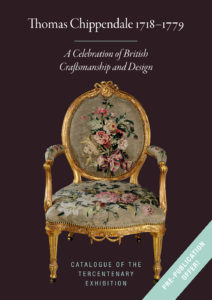 In preparing the series this blog entry will now conclude, it has been great fun reviewing just the Chippendale material in my own library, and having the excuse then to top it up with the catalog for the Leeds City Museum exhibition curated and catalog penned by Adam Bowett and James Lomax, and the Metropolitan Museum’s Bulletin from earlier this year ‘Chippendale’s Director: A Manifesto of Furniture Design’, written by curator emeritus Morrison Heckscher.
In preparing the series this blog entry will now conclude, it has been great fun reviewing just the Chippendale material in my own library, and having the excuse then to top it up with the catalog for the Leeds City Museum exhibition curated and catalog penned by Adam Bowett and James Lomax, and the Metropolitan Museum’s Bulletin from earlier this year ‘Chippendale’s Director: A Manifesto of Furniture Design’, written by curator emeritus Morrison Heckscher.
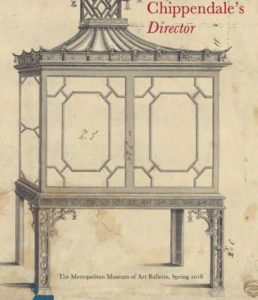 Enjoyable, but as I conclude this series have to admit not entirely fulfilling. As I pointed out during this series and will now summarize still very, very many questions remain unanswered about Chippendale and while the current state of scholarship acknowledges a great debt to the late Christopher Gilbert with his researches contained within his compendious 1978 The Life and Work of Thomas Chippendale, there is not, if anything, really new to add.
Enjoyable, but as I conclude this series have to admit not entirely fulfilling. As I pointed out during this series and will now summarize still very, very many questions remain unanswered about Chippendale and while the current state of scholarship acknowledges a great debt to the late Christopher Gilbert with his researches contained within his compendious 1978 The Life and Work of Thomas Chippendale, there is not, if anything, really new to add.
What Gilbert called ‘the undiscovered years’ in Chippendale’s life pose an enormous problem in that save Chippendale’s marriage in 1747, nothing is known about his training and London life until just before the initial publication of The Gentleman & Cabinet-Maker’s Director in 1754. Gilbert, Bowett & Lomax, and Heckscher all consider the preparation of the drawings and their publication a feat that, in one fell swoop, established the primacy of Chippendale in the history of the decorative arts. How it was that Chippendale arrived at this point, from whom he received his training, and how he became such an accomplished designer no one can say. Scholarship is replete with shorthandedly conclusive statements about his excellence. When his training as a draughtsman and designer is considered, if it is considered at all, it is assumed that with his proximity to the hothouse environment of the St Martin’s Lane Academy, there were plenty of opportunities for Chippendale to have learned.
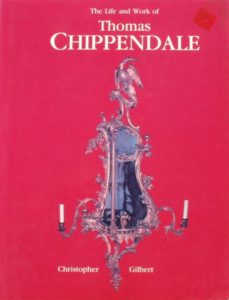
Reasonable enough, but with an output sufficiently prodigious to fill the Director, it seems unreasonable that some significant production did not precede it. Heckscher indirectly takes this issue on board, arguing as he does for the drawings in the collection of the Met to be the work of Chippendale himself and witness to Chippendale’s mastery of the pencil. Perhaps. I would though be interested to pursue the work of Chippendale’s boon companion Matthias Darly, a draughtsman of established ability whose published designs predate Chippendale’s, as a collaborator whose work might have extended considerably beyond merely that of the engraver of the plates in the Director.
As much as any other significant figure in the life of Thomas Chippendale, I would like more research given over to the life of James Rannie. What was it that brought the two of them together right at the time of the preparation and publication of the first edition of the Director? While it is assumed by scholars that its publication was, through the assistance of its subscribers, a venture that was self financed, it is also known that some of these ‘subscribers’ were only named honorifically. I suspect that Rannie provided some kind of financial surety for the publication, just as he did for the substantial expansion of Chippendale’s business, with the move to large quarters in St Martin’s Lane almost simultaneous to the publication of the Director.
I suppose the greatest occurrences in Chippendale studies in the last generation are the events surrounding the almost-sale of the contents of Dumfries House. The examination of the pieces contained in this commission provided an opportunity to consider first hand and in-depth Chippendale’s output at about the time of the issuance of the Director, and also, when looking at the items produced by Scottish craftsmen to Director designs, to consider the nature and extent of Chippendale’s influence. With all that, I can’t really say that Dumfries House went any further to elucidate Chippendale’s career up to the establishment of his shop in St Martin’s Lane. It did, though, when looking at the pieces copied from the Director but known to have been completed by other craftsmen, put paid to any notion that the execution of a Director design can then be automatically attributed to the master.
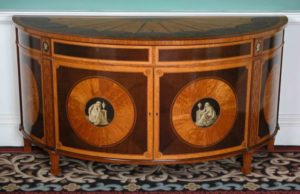
Marquetry demilune commode, attributable to Thomas Chippendale the younger, Stourhead, National Trust
In spite of the fact that the Chippendale workshop carried on in one form or another for some 40 years after the death of Thomas Chippendale the elder, little attention has been paid, even during this tercentenary year, to Thomas Chippendale the younger. Some of the workshop’s greatest commissions, including the neoclassical pieces at Harewood and Stourhead were executed under the direction of Thomas Chippendale the younger- Harewood perhaps to a lesser extent, Stourhead in its entirety. The Chippendale legacy, despite this, is something that attaches to the elder, and seems always to exist as some kind of footnote to the powerful influence of the first edition of the Director.
The why of this legacy is another aspect that seems not completely resolved, as popular passion for the fanciful rococo, with the Chinoiserie and ‘Gothick’ designs always with a heavy admixture of the rococo, was a short-lived phenomenon in Britain, from around 1740 to 1760, and certainly no later than 1770. As a fashion, it was displaced thoroughly by the classical antiquarianism of Stuart, Adam, and later, Thomas Hope, and then still later the studied English Gothic antiquarianism of Pugin.
While the various revivals of interest in Chippendale proceeded apace in the 19th century, it is surprising that interest in his mid-18th century contemporaries did not. William Hallett, Vile & Cobb, the Linnells, and Ince and Mayhew produced some remarkable commissions during the 18th century, enjoying royal patronage where Chippendale did not. As well, Ince and Mayhew’s 1762 Universal System of Household Furniture was as a collection of designs considered even by Chippendale of such significance it stimulated him to revise and then reissue an updated edition of the Director.
Still and all, no one has been lionized the way Chippendale has. Although a statue of Chippendale the elder adorns the façade of the V & A, one wonders whether this might not be a reflection at least in part of the esteem in which he was held in America. At the turn of the last century, very many museums, and most notably the Metropolitan Museum in New York, were at what appears their busiest in building collections of American decorative arts, and in the course of this, sought to add a bit of sophisticated lustre to pieces that were created so far from the style centres of London and the mother country. It is known that the Director did early on find its way to colonial America, as it found its way throughout Europe. It was perhaps the attempts of curators and collectors at the time to promote the mastery of American craftsmen by linking them stylistically with Chippendale. And over time, this became amongst collectors and museums a responsive chorus, trumpeting the name of Chippendale back and forth across the Atlantic. America’s prosperity in the late 19th and early 20th centuries financed the ability of private and institutional collectors to bring back from England ‘authentic’ Chippendale pieces. ‘Authentic’ in quotes, as very much of what was given pride of place on this side of the pond has, over time, been shown to be shall we say of specious attribution, supported not by provenance but only by a resemblance, and often only the vaguest, to a Director design.
Collectors of all stripes and dealers in the accredited trade in art and antiques are generally now much, much more cautious in handing out attributions, and but with the welter of scholarship in this tercentenary year it is surprising one still hears the proper name ‘Chippendale’ used so frequently as an adjective. Watching the American ‘Antiques Roadshow’ experts who should know better yet describe almost any furniture piece from the 18th or 19th centuries as ‘Chippendale style’- or even more broadly and less accurately ‘Chippendale period’- if it is only possessed of a cabriole leg or ball and claw foot.
Gaucherie on TV is nothing new, though, but it was surprising to read Morrison Hecksher’s opinion that whoever made it, and presumably whenever it was made, if it is to a Chippendale design, any piece can ‘legitimately’ (his term) be called Chippendale. Heckscher’s rationale is derived from statements by Chippendale within the Director, that a cabinetmaker could mix or match various motifs within the book to achieve, depending on the skill of the cabinetmaker, a good and pleasing result. While on the one hand, there is no question Chippendale expected his designs would be cribbed, on the other, he did seek to strongly imply that the proper execution of his excellently rendered designs could be wrought with excellent results in his own workshop. In this respect, I am in slight disagreement with Heckscher- the primary purpose for the publication of the Director in 1754 was to promote the business of Thomas Chippendale and James Rannie.
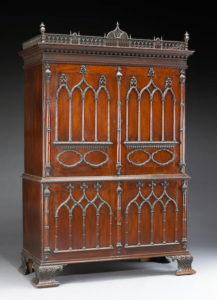
Ex collection of LACMA- Chippendale, not!
It might be noted that pieces at one time cataloged as by Chippendale have been shall we say reassessed and then sold off by institutional collectors. The Los Angeles County Museum of Art was formerly possessed of and then several years ago sold off a large case piece that had just fairly recently been acquired and attributed to Thomas Chippendale. A more knowledgeable curator spotted the piece straightaway as a later confection cobbled together from what we in the trade call ‘period elements.’ Of course institutional collectors are biased toward their own collections and just an example or two aren’t precisely illustrative, but it does beg question whether to avoid the embarrassment of incorrect attributions, institutional collectors might be complicit to some degree in stymying advances in Chippendale scholarship.
As I consider this tercentenary year as it moves to its close there is room for very, very much more scholarship on the subject of Thomas Chippendale. For me, as for very many other people, 2018 then hopefully becomes the year in which an interest in Chippendale is not revived, but rather renewed and reinvigorated, and perhaps that renewal of interest will mark this as a time of beginning for additional scholarship and discoveries.
